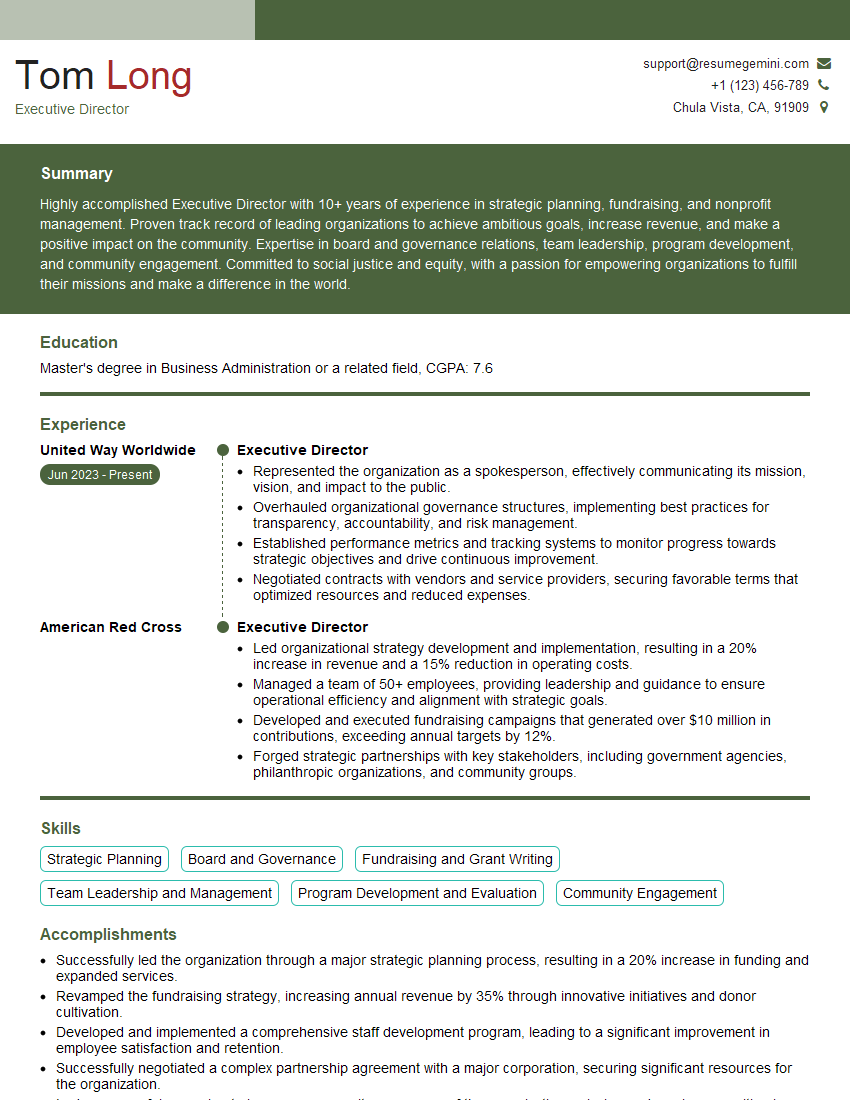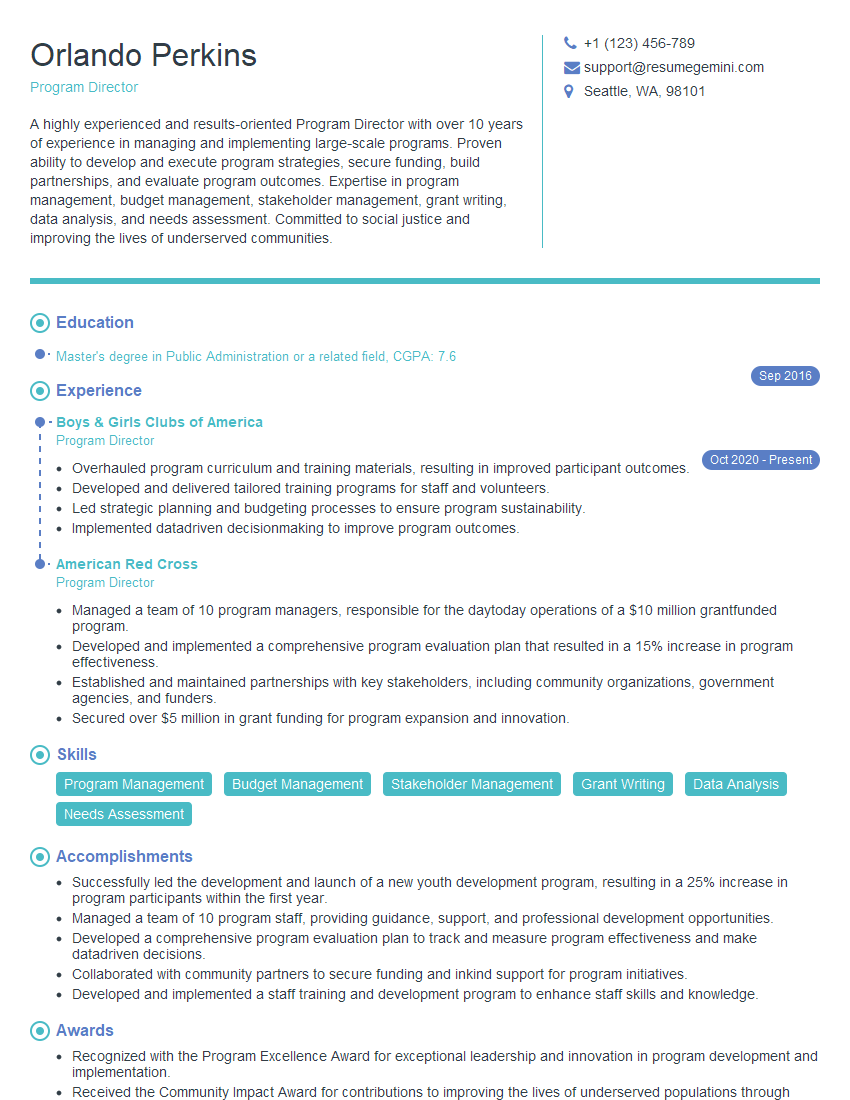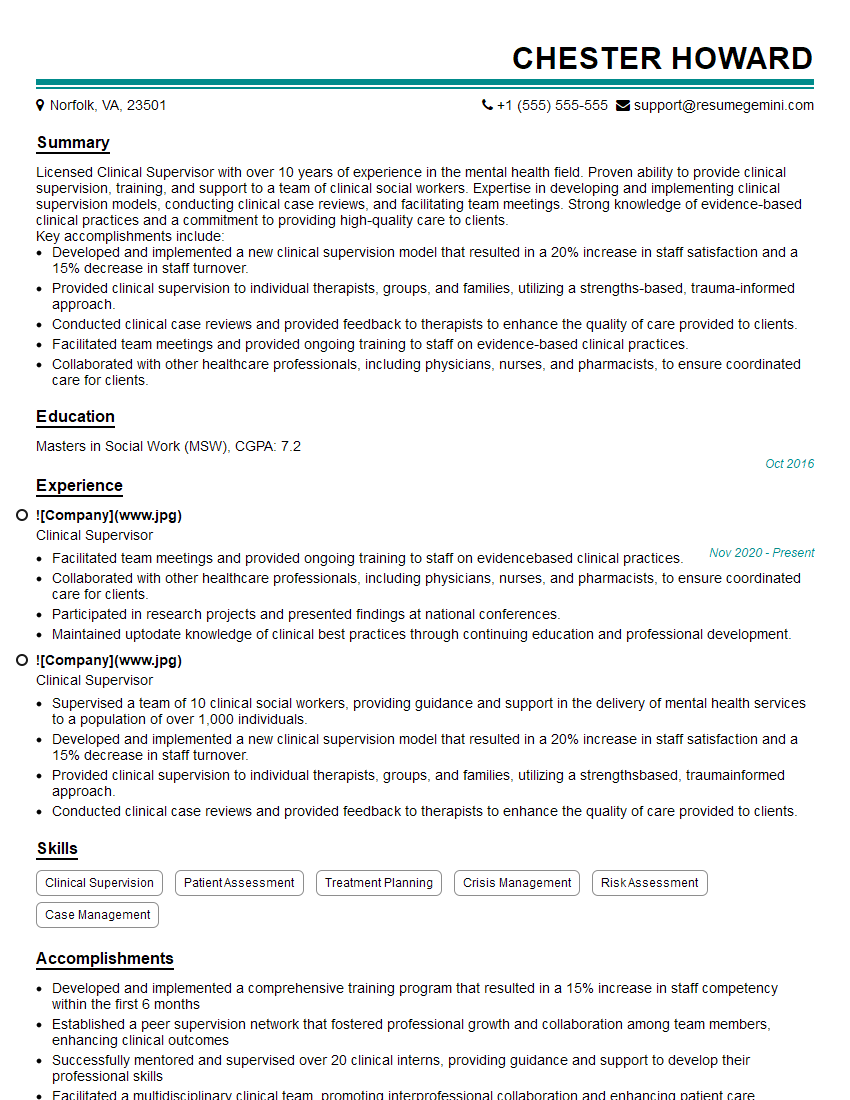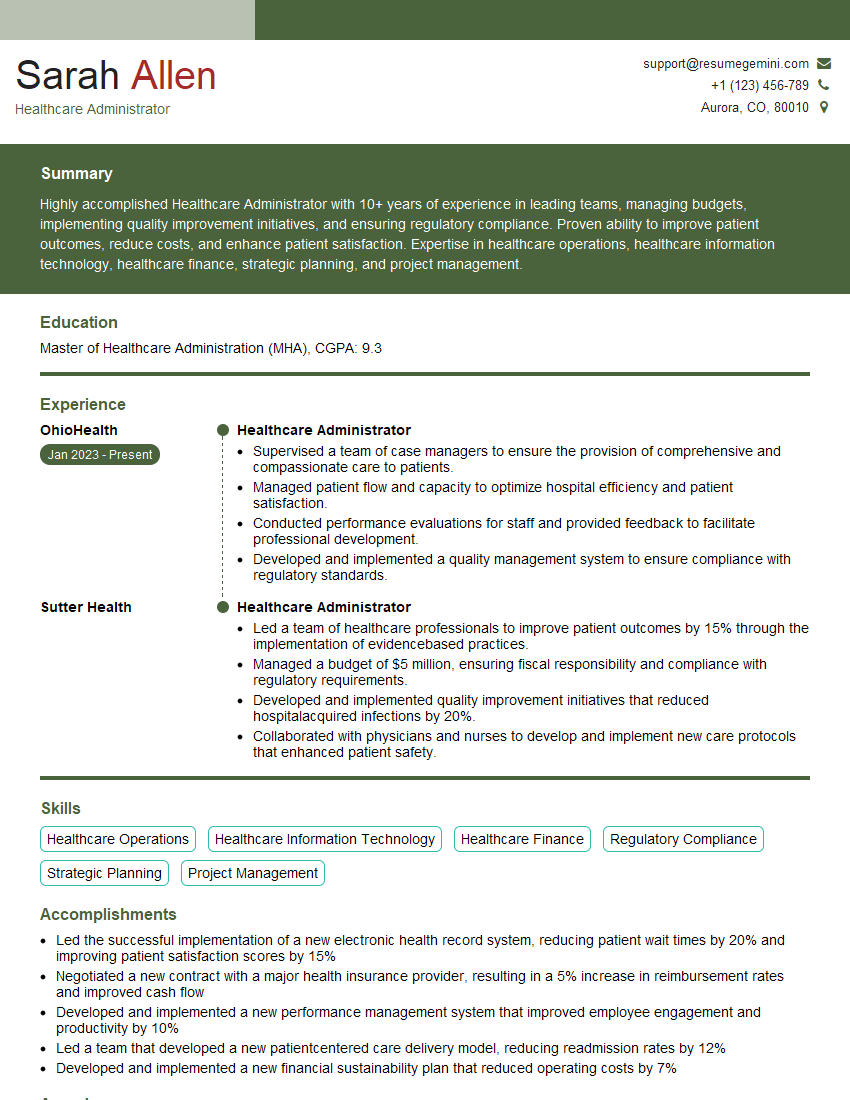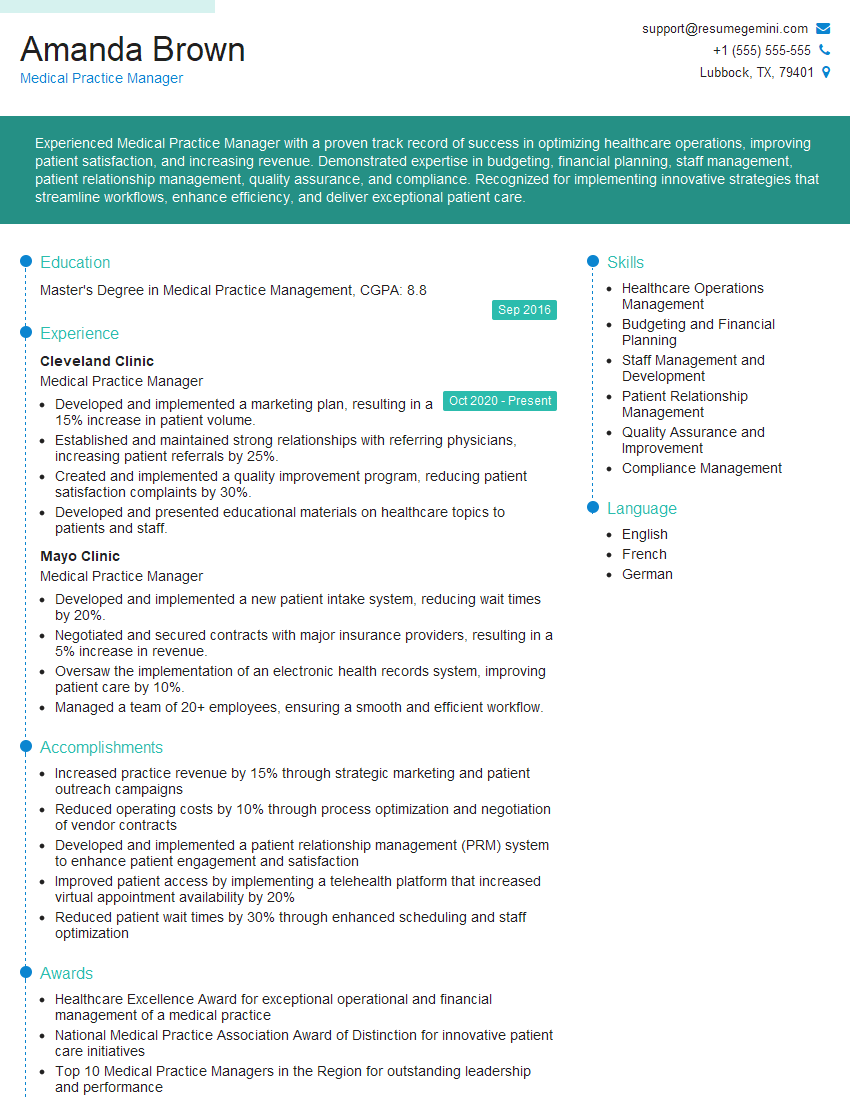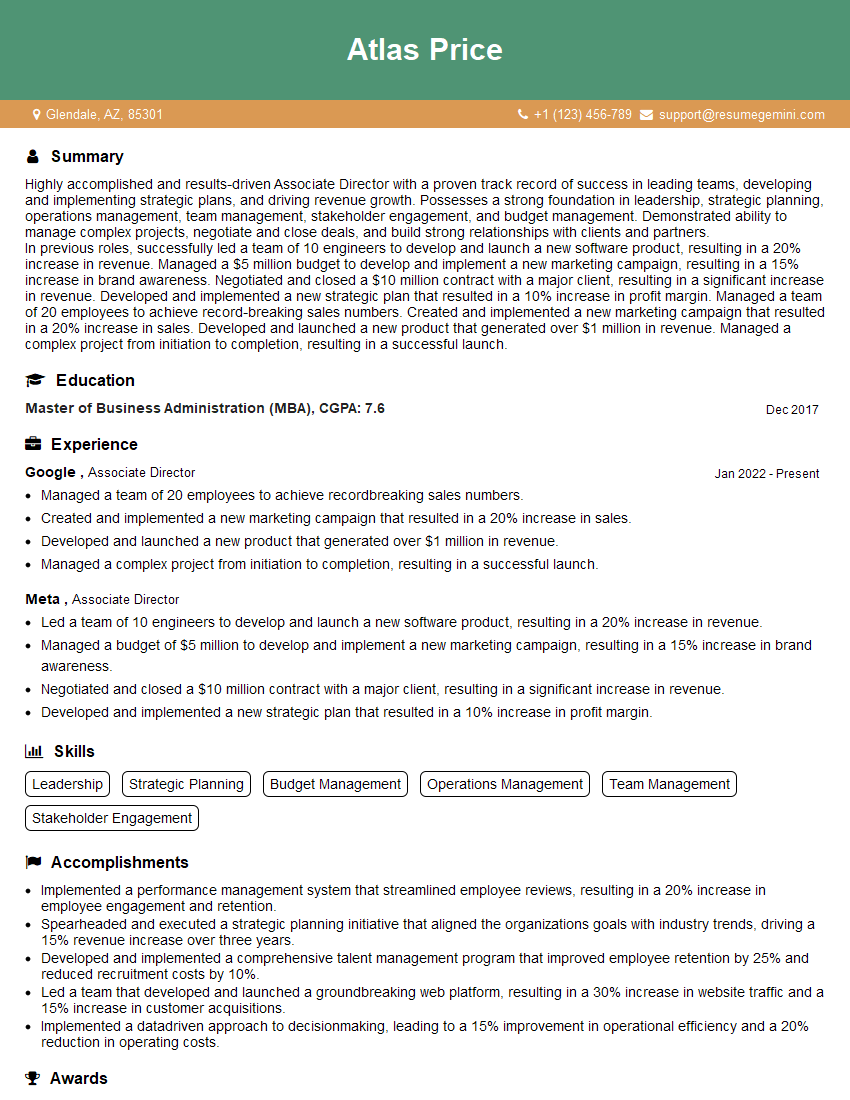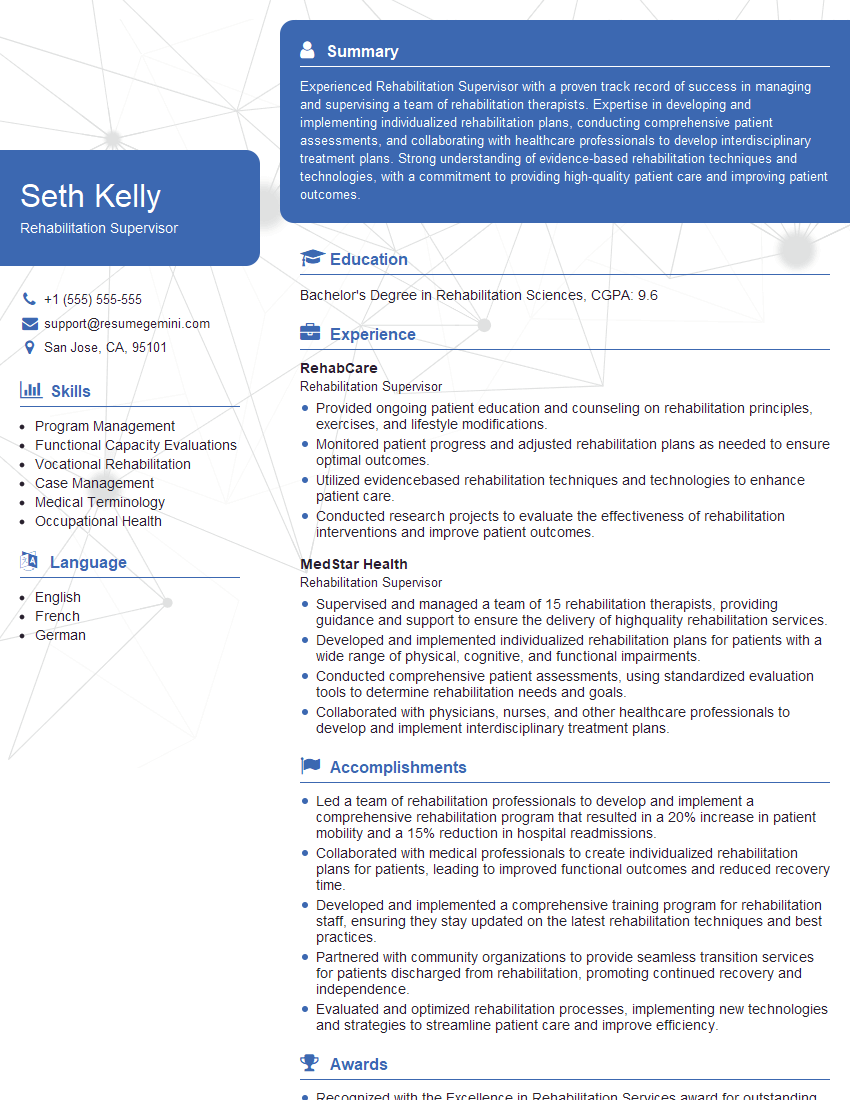Are you ready to stand out in your next interview? Understanding and preparing for Practice Planning and Supervision interview questions is a game-changer. In this blog, we’ve compiled key questions and expert advice to help you showcase your skills with confidence and precision. Let’s get started on your journey to acing the interview.
Questions Asked in Practice Planning and Supervision Interview
Q 1. Describe your experience in developing and implementing practice policies and procedures.
Developing and implementing practice policies and procedures is crucial for ensuring consistent, high-quality care and efficient operations. My approach involves a collaborative, data-driven process. I begin by thoroughly analyzing current workflows, identifying gaps, and assessing best practices within the field. This involves reviewing relevant literature, benchmarking against other successful practices, and soliciting input from all staff members.
For example, in a previous role, we streamlined our client intake process by implementing an online portal. This reduced administrative burden, improved client experience, and allowed for better data tracking. The new process was documented clearly, including step-by-step instructions and frequently asked questions, to ensure staff understanding and consistent application.
Following the development phase, I prioritize robust training and ongoing monitoring. This includes regular staff meetings, updates on policy changes, and feedback mechanisms to identify and address any emerging issues. The ultimate goal is to establish policies that are not only effective but also practical, promoting a positive and productive work environment.
Q 2. How do you ensure compliance with relevant regulations and ethical guidelines in your practice?
Compliance is paramount. I ensure adherence to all relevant regulations and ethical guidelines through a multi-faceted approach. This starts with a deep understanding of the legal and ethical frameworks governing our practice, including HIPAA, state licensing regulations, and professional codes of ethics. Staying updated on these ever-evolving standards is critical, and I utilize continuing education opportunities, professional memberships, and regular legal consultations to maintain current knowledge.
Furthermore, we have established internal processes for auditing compliance. This includes regular reviews of clinical documentation, financial records, and client interactions to ensure that policies and procedures are being consistently followed. Any identified gaps or areas for improvement are addressed promptly through retraining, policy revisions, or other appropriate measures. We also maintain a culture of open communication, encouraging staff to report any concerns related to compliance proactively. This preventative approach helps mitigate risk and promote a culture of ethical conduct.
Q 3. Explain your approach to performance management and supervision of team members.
Performance management is a key aspect of my approach to supervision. My strategy centers around a combination of constructive feedback, goal setting, and ongoing support. I believe in regular one-on-one meetings with team members to discuss their progress, challenges, and professional development goals. This open dialogue helps to identify areas of strength and opportunities for improvement.
Performance expectations are clearly defined, often through the creation of individual performance plans that align with overall practice goals. These plans outline specific, measurable, achievable, relevant, and time-bound (SMART) objectives. Regular progress reviews allow for timely adjustments and address any potential roadblocks. I provide tailored mentorship, professional development opportunities, and resources to help staff meet their objectives. This holistic approach enhances both individual and team performance.
Constructive feedback is essential. I focus on providing specific, actionable feedback, both positive and constructive, with an emphasis on coaching and support rather than criticism. I regularly use methods like 360-degree feedback to gather diverse perspectives on performance.
Q 4. How do you handle conflict resolution within a clinical team?
Conflict resolution within a team requires a proactive and empathetic approach. My strategy focuses on early intervention and creating a safe space for open communication. I encourage team members to address conflicts directly, using active listening and respectful dialogue. When direct intervention is necessary, I facilitate structured conversations that aim to identify the root cause of the conflict, understand each individual’s perspective, and collaboratively develop mutually acceptable solutions. This may involve mediation or the application of conflict-resolution models, such as collaborative problem-solving.
Confidentiality is crucial. During conflict resolution, I ensure all parties feel comfortable expressing their views without fear of reprisal. I emphasize a focus on the issue at hand, rather than making it personal. My role is to facilitate a process that leads to a productive outcome, restoring positive working relationships and enhancing overall team cohesion. If the conflict involves serious misconduct, I would adhere to established policies and procedures, which may include disciplinary action.
Q 5. Describe your experience in strategic planning for practice growth and development.
Strategic planning for practice growth involves a comprehensive and future-oriented approach. I start by conducting a thorough SWOT (Strengths, Weaknesses, Opportunities, Threats) analysis to assess the practice’s current state and identify potential areas for development. This involves analyzing market trends, competitor activities, and client demographics to identify unmet needs and opportunities for expansion.
Based on this assessment, I develop a strategic plan that outlines specific, measurable goals and objectives. This might include expanding service offerings, recruiting new staff, implementing new technologies, or targeting new client populations. The plan also includes timelines, resource allocation, and key performance indicators (KPIs) to track progress and measure success. Regular monitoring and adjustments are crucial to ensure the plan remains relevant and effective. For example, in the past, I spearheaded a successful initiative to incorporate telehealth services, expanding our reach and improving client access to care.
Q 6. How do you evaluate the effectiveness of practice-based interventions?
Evaluating the effectiveness of practice-based interventions is critical for continuous improvement. My approach involves a combination of quantitative and qualitative data collection methods. Quantitative methods might include tracking key metrics such as client satisfaction scores, treatment outcomes, and cost-effectiveness. Qualitative data, gathered through client feedback surveys, staff interviews, and case studies, provides valuable insights into the experiences and perceptions surrounding the intervention.
Data analysis helps to determine whether the intervention achieved its intended goals and identify areas for improvement. For instance, if we implement a new treatment protocol, we would track client outcomes to see if it leads to better results compared to previous approaches. Client feedback surveys would help gauge satisfaction and identify areas where the protocol could be refined. This iterative process of data collection, analysis, and refinement is essential for continuous improvement and ensuring that our interventions remain effective and efficient.
Q 7. How do you monitor and improve the quality of services provided in your practice?
Monitoring and improving service quality is an ongoing process that requires a proactive and systematic approach. I employ several strategies, including regular quality assurance audits, client satisfaction surveys, staff feedback mechanisms, and performance data analysis. Audits focus on reviewing clinical documentation, adherence to protocols, and overall operational efficiency. Client satisfaction surveys provide valuable insights into client experiences and help identify areas where improvements are needed.
Staff feedback is crucial for identifying potential issues and promoting a culture of continuous improvement. We utilize both formal methods, such as staff meetings and performance reviews, as well as informal approaches, such as open-door policies and suggestion boxes. Performance data, such as treatment outcomes and wait times, are regularly analyzed to identify trends and areas for improvement. Addressing these issues through process improvements, staff training, or policy changes ensures that we consistently provide high-quality care that meets the needs of our clients.
Q 8. What is your experience with budgeting and financial management within a clinical setting?
Budgeting and financial management are critical for the sustainability and success of any clinical practice. My experience encompasses developing and managing budgets, tracking revenue and expenses, forecasting financial performance, and ensuring compliance with all relevant regulations. I’m proficient in using various financial software and tools to monitor key performance indicators (KPIs) such as profitability, cost per patient, and revenue cycle management.
For example, in my previous role, I implemented a new billing system that streamlined the process, reducing claim denials by 15% and significantly improving cash flow. I also developed a detailed annual budget that accurately projected revenue and expenses, leading to a 10% increase in profitability within a year. I believe in a proactive approach, regularly reviewing financial data to identify areas for improvement and preventing potential financial shortfalls. This involves constant monitoring of expenses, negotiating favorable rates with suppliers, and exploring opportunities for revenue enhancement.
Q 9. Describe your experience with risk management and mitigation strategies in a clinical practice.
Risk management is paramount in a clinical setting to protect patients, staff, and the organization. My experience involves implementing and overseeing risk mitigation strategies across various areas, including patient safety, legal compliance, and financial stability. This includes developing and regularly reviewing risk assessments, creating and implementing policies and procedures to address identified risks, and conducting regular staff training on risk management protocols.
For instance, I established a robust system for managing medication errors, involving regular audits of medication administration procedures, implementation of double-checking protocols, and prompt reporting and investigation of any incidents. Another example is developing a comprehensive incident reporting system that ensures thorough documentation and investigation of any adverse events, leading to proactive mitigation strategies and a reduction in future incidents. I consider risk management an ongoing process requiring continuous monitoring, adaptation, and improvement based on emerging trends and best practices.
Q 10. How do you ensure data privacy and confidentiality within your practice?
Data privacy and confidentiality are of utmost importance, and I adhere strictly to all relevant regulations, such as HIPAA in the US. My approach encompasses establishing clear policies and procedures regarding data handling, access control, and security protocols. This includes encrypting sensitive data both in transit and at rest, implementing strong password policies, and conducting regular security audits to identify and address any vulnerabilities.
Staff training on data privacy and security is a continuous process. We use role-based access control to ensure that only authorized personnel can access sensitive patient information. Furthermore, we utilize secure data disposal methods for any paper or electronic records that are no longer required. Regular reviews of our policies and procedures ensure they align with evolving best practices and regulatory requirements. I consider patient privacy a fundamental aspect of ethical and professional practice and actively foster a culture of data protection within the entire team.
Q 11. What is your approach to staff training and professional development?
Investing in staff training and professional development is essential for a high-performing and engaged team. My approach involves a multi-faceted strategy incorporating various learning methods. This includes regularly scheduled in-service trainings on relevant clinical topics, access to professional development opportunities such as conferences and workshops, mentorship programs to support career growth, and opportunities for skill enhancement through online courses and certifications.
For example, I developed a tailored training program for my team focused on trauma-informed care, significantly improving our ability to effectively support clients with trauma histories. Regular performance reviews offer opportunities for feedback and identify areas for individual development. I also encourage continuous learning and actively support staff members in pursuing advanced certifications or specializations relevant to their roles. This investment not only improves the quality of care we provide but also enhances staff morale and retention.
Q 12. Describe your experience with implementing and managing electronic health records (EHRs).
Implementing and managing electronic health records (EHRs) requires a comprehensive approach. My experience includes selecting and implementing EHR systems, training staff on their use, developing workflows to optimize efficiency, and ensuring data integrity and security. I understand the importance of choosing a system that aligns with the practice’s needs and workflow, and I am familiar with various EHR systems and their functionalities.
For example, in a previous role, I led the transition to a new cloud-based EHR system. This involved thorough planning, staff training, data migration, and ongoing system maintenance. The successful implementation resulted in improved efficiency, reduced paperwork, and enhanced data accessibility. Ongoing monitoring of system performance, addressing technical issues promptly, and regularly updating the system with necessary security patches are crucial for successful EHR management. Regular data backups and disaster recovery planning are essential components of a robust EHR system strategy.
Q 13. How do you handle client complaints and concerns?
Handling client complaints and concerns is an essential aspect of providing quality care and maintaining a positive practice environment. My approach focuses on active listening, empathy, and a commitment to resolving issues fairly and efficiently. I establish a clear process for receiving and addressing complaints, ensuring that all concerns are documented thoroughly and investigated promptly.
For example, I developed a structured process for handling client complaints that includes acknowledging the complaint promptly, investigating the matter thoroughly, and communicating the findings and resolution to the client in a timely manner. This process prioritizes open communication and provides clients with an avenue for expressing their concerns without feeling dismissed or ignored. In situations where a complaint involves a potential breach of ethical standards or legal violations, I ensure proper reporting and adherence to all relevant regulatory guidelines. I believe that effectively managing client concerns contributes significantly to building trust and enhancing the reputation of the practice.
Q 14. Explain your process for conducting performance appraisals for supervisees.
Conducting performance appraisals for supervisees is a critical aspect of supervision and involves a structured approach combining objective data with subjective observations. My process starts with establishing clear expectations and goals at the beginning of the supervisory relationship, which then form the basis for evaluating performance. I use a multi-faceted approach, incorporating self-assessment from the supervisee, observation of their work, review of their case notes, and feedback from clients (where appropriate and ethically sound).
The appraisal meeting is a collaborative discussion focused on both strengths and areas needing improvement. I provide specific and constructive feedback, focusing on observable behaviors and their impact. We collaboratively develop a performance improvement plan (PIP) if necessary, outlining specific goals, strategies, and timelines. The entire process emphasizes open communication, mutual respect, and a commitment to supporting the supervisee’s professional growth and development. Regular feedback throughout the year, rather than just relying on annual reviews, is crucial for effective supervision.
Q 15. How do you promote a positive and supportive work environment for your team?
Creating a positive and supportive work environment is paramount for a thriving practice. It’s not just about happy employees; it’s about fostering collaboration, boosting morale, and ultimately, improving client outcomes. I approach this through a multi-faceted strategy:
Open Communication: Regular team meetings, both formal and informal, are crucial. These provide opportunities to share updates, address concerns, and brainstorm solutions. We utilize a transparent communication system, ensuring everyone is informed and feels heard. For instance, we use a shared online project management tool to track progress and discuss challenges openly.
Mutual Respect and Value: I actively promote a culture of respect where everyone’s contributions are valued. This involves recognizing individual achievements, both big and small, providing constructive feedback, and offering opportunities for professional development. I believe in leading by example, showing respect for everyone’s time and opinions.
Work-Life Balance: Recognizing the importance of well-being, we promote a healthy work-life balance. This includes flexible work arrangements where possible, encouraging the use of vacation time, and providing access to employee assistance programs. A burned-out team is an unproductive team.
Team-Building Activities: We regularly engage in team-building activities, both inside and outside the workplace. These can be anything from casual lunch gatherings to participating in community service projects. These activities help build camaraderie and stronger working relationships.
Career Expert Tips:
- Ace those interviews! Prepare effectively by reviewing the Top 50 Most Common Interview Questions on ResumeGemini.
- Navigate your job search with confidence! Explore a wide range of Career Tips on ResumeGemini. Learn about common challenges and recommendations to overcome them.
- Craft the perfect resume! Master the Art of Resume Writing with ResumeGemini’s guide. Showcase your unique qualifications and achievements effectively.
- Don’t miss out on holiday savings! Build your dream resume with ResumeGemini’s ATS optimized templates.
Q 16. Describe your experience with marketing and outreach to attract new clients.
Marketing and outreach are essential for attracting new clients. My approach is strategic and multifaceted, combining traditional and digital methods:
Networking: I actively participate in professional organizations and attend relevant conferences and workshops. Networking events provide opportunities to connect with potential referral sources and build relationships within the community.
Online Presence: Maintaining a professional and informative website and utilizing social media platforms are critical. We regularly update our website with relevant content and use social media to share valuable information and engage with potential clients. We also utilize search engine optimization (SEO) techniques to improve our online visibility.
Content Marketing: Creating and distributing valuable content, such as blog posts, articles, and webinars, establishes us as thought leaders and attracts potential clients seeking our expertise. This positions us as valuable resources within our field.
Public Relations: We actively seek opportunities to be featured in local media outlets or publications. This boosts our brand recognition and credibility.
Referral Program: We have a robust referral program that rewards existing clients for recommending our services to others. Word-of-mouth marketing remains a highly effective tool.
For example, a recent successful campaign involved creating a series of informative videos on our services, which we then promoted across social media and on our website. This resulted in a significant increase in inquiries and new client acquisition.
Q 17. How do you stay current with best practices and emerging trends in your field?
Staying current is vital in any field, and particularly crucial in practice planning and supervision. I employ several strategies to keep abreast of best practices and emerging trends:
Professional Development: I regularly attend conferences, workshops, and seminars related to practice management, supervision, and relevant clinical areas. I also participate in continuing education courses to maintain my professional certifications.
Professional Organizations: I am an active member of relevant professional organizations, such as [mention relevant organizations]. These organizations provide access to cutting-edge research, publications, and networking opportunities.
Journals and Publications: I regularly read peer-reviewed journals and industry publications to stay informed about the latest research and best practices. This allows me to adapt and refine my strategies based on the latest evidence.
Online Resources: I utilize online resources, such as reputable websites and databases, to access information and training materials. I also follow thought leaders and experts in the field on social media platforms.
Mentorship and Peer Consultation: I actively engage in mentorship and peer consultation with other experienced professionals in the field. These interactions allow for sharing of best practices and learning from each other’s experiences.
Q 18. How do you ensure the sustainability and long-term viability of the practice?
Ensuring the long-term sustainability of a practice requires a proactive and multifaceted approach. This involves:
Financial Planning: Developing and regularly reviewing a sound financial plan is essential. This includes budgeting, forecasting, and managing cash flow effectively. Investing wisely in technology and resources also contributes to long-term viability.
Strategic Planning: We regularly engage in strategic planning to anticipate future trends and challenges. This involves assessing market demands, identifying potential opportunities, and adapting our services accordingly. A long-term vision and adaptability to changing circumstances are crucial.
Client Retention: High client retention rates are essential for sustainability. We focus on providing exceptional service and building strong relationships with our clients. This helps to ensure client loyalty and reduce reliance on constant new client acquisition.
Risk Management: A robust risk management plan is crucial for protecting the practice from potential threats. This includes addressing liability concerns, developing protocols for managing crises, and ensuring regulatory compliance.
Team Development: Investing in the training and development of our team is crucial. A skilled and motivated team is essential for the success and longevity of the practice.
Q 19. Describe a time you had to make a difficult decision regarding practice operations.
One challenging decision involved a staff member who was consistently underperforming despite multiple opportunities for improvement. While I valued the individual’s contributions in other areas, their performance in a critical role was impacting the overall efficiency and effectiveness of the team. After careful consideration, and following established progressive disciplinary procedures, the difficult decision was made to let the staff member go. This decision, while painful, was ultimately necessary to maintain the quality of services provided and the overall health of the practice. I ensured a fair and transparent process, providing clear communication and support throughout.
Q 20. How do you manage time effectively to balance multiple responsibilities within the practice?
Effective time management is crucial in balancing multiple responsibilities. I utilize several strategies:
Prioritization: I utilize techniques such as the Eisenhower Matrix (urgent/important) to prioritize tasks based on their impact and urgency. This ensures I focus on high-impact activities first.
Time Blocking: I allocate specific time blocks for different tasks and activities. This helps to maintain focus and prevent multitasking, which often reduces efficiency.
Delegation: I effectively delegate tasks to team members, empowering them to manage their own workloads. This frees up my time to focus on strategic priorities.
Technology: I leverage technology to streamline administrative tasks and improve efficiency. This includes using project management software, scheduling tools, and other applications to enhance productivity.
Regular Review: I regularly review my schedule and adjust my priorities as needed. This allows for flexibility and adaptation to changing circumstances.
Q 21. How do you delegate tasks effectively to team members?
Effective delegation involves more than just assigning tasks; it’s about empowering team members and fostering their growth. My approach involves:
Clear Communication: I provide clear and concise instructions, outlining the task’s objectives, deadlines, and expected outcomes. I ensure the team member understands the context and the importance of the task.
Matching Skills and Abilities: I delegate tasks based on each team member’s skills and experience, ensuring they are well-suited to the assignment. This allows them to utilize their strengths and enhances their confidence.
Providing Support and Resources: I provide the necessary resources, tools, and support to ensure team members can successfully complete their assigned tasks. This includes access to training, mentoring, and any required materials.
Monitoring and Feedback: I regularly monitor progress and provide constructive feedback to ensure the task is on track and to identify any challenges early on. This also provides opportunities for coaching and professional development.
Empowerment and Trust: I trust my team members to take ownership of their assigned tasks and make independent decisions within defined parameters. This fosters a sense of responsibility and promotes their professional growth.
Q 22. What are your strategies for improving efficiency and productivity within the practice?
Improving efficiency and productivity in a practice requires a multi-pronged approach focusing on streamlining processes, optimizing resource allocation, and empowering the team. It’s not just about working harder, but working smarter.
- Process Mapping and Optimization: I begin by thoroughly mapping existing workflows to identify bottlenecks and redundancies. For example, if our appointment scheduling system is inefficient, leading to wasted time for both staff and clients, I’d implement a new system or modify the current one to improve its speed and ease of use. This could involve adopting online scheduling tools or optimizing appointment durations based on data analysis.
- Technology Integration: Leveraging technology is crucial. This might involve implementing electronic health record (EHR) systems, telehealth platforms, or project management software to improve communication, data management, and task allocation. For instance, using a centralized communication platform like Slack can significantly reduce email clutter and improve team responsiveness.
- Delegation and Training: Effective delegation is key. I ensure that tasks are assigned according to skill sets and workload, providing adequate training and support to team members to handle their responsibilities effectively. This empowerment fosters a sense of ownership and reduces the burden on key personnel. For example, I might train administrative staff to handle certain aspects of client communication, freeing up clinicians for direct patient care.
- Performance Monitoring and Feedback: Regular monitoring of key performance indicators (KPIs), such as appointment wait times, client satisfaction scores, and staff turnover rates, provides valuable data to identify areas for improvement. Constructive feedback and regular team meetings are essential to address challenges and celebrate successes.
By systematically addressing these areas, I can create a more efficient and productive work environment that benefits both the team and the clients we serve.
Q 23. How do you foster collaboration and teamwork within a multidisciplinary team?
Fostering collaboration and teamwork in a multidisciplinary setting requires creating a culture of respect, open communication, and shared goals. It’s about building a team, not just assembling individuals.
- Regular Team Meetings: Structured meetings, with clear agendas and defined roles, provide a platform for sharing updates, brainstorming solutions, and addressing challenges collaboratively. These meetings should foster open dialogue and encourage everyone to contribute.
- Shared Goals and Objectives: Establishing clear, shared goals ensures everyone is working towards a common vision. This aligns individual efforts and promotes a sense of collective accomplishment. For example, setting a team goal of reducing client wait times by 15% within a quarter provides a concrete target for everyone to strive for.
- Conflict Resolution Mechanisms: Having established processes for resolving conflicts is crucial. This might involve mediation or conflict resolution training for team members, ensuring disagreements are addressed constructively and professionally. The goal is to turn conflict into an opportunity for growth and improvement.
- Interprofessional Education and Training: Providing opportunities for team members from different disciplines to learn from each other builds understanding and respect. This could involve workshops, shadowing opportunities, or joint case studies.
- Celebrating Successes: Recognizing and celebrating team achievements, both big and small, reinforces positive behaviors and strengthens team cohesion.
By cultivating a positive and collaborative environment, I create a team that is not only more effective but also more resilient and engaged.
Q 24. What is your experience with using data and analytics to inform practice decisions?
Data and analytics are invaluable tools for making informed practice decisions. I have extensive experience leveraging data to improve patient care, optimize resource allocation, and enhance overall practice performance.
- Performance Monitoring: I utilize data to track key performance indicators (KPIs) such as client satisfaction, appointment wait times, treatment effectiveness, and operational costs. This data-driven approach allows for proactive identification of areas needing improvement.
- Outcome Measurement: I analyze treatment outcomes to assess the effectiveness of various interventions and adjust approaches as needed. This might involve tracking client progress using standardized measures and comparing results across different treatment modalities.
- Resource Allocation: Data analysis helps optimize resource allocation by identifying areas where resources are underutilized or overutilized. For example, analyzing appointment scheduling data might reveal patterns of under- or over-booking, allowing for adjustments to scheduling practices.
- Predictive Analytics: In some cases, I leverage predictive analytics to anticipate future trends and plan accordingly. For instance, forecasting client demand based on historical data allows for proactive staffing adjustments and resource allocation.
My experience includes using various software and statistical methods to analyze data, including descriptive statistics, regression analysis, and data visualization techniques. This allows me to present findings clearly and persuasively to stakeholders.
Q 25. Describe your experience with developing and implementing quality improvement initiatives.
Developing and implementing quality improvement (QI) initiatives is a core component of my approach to practice management. My experience spans various QI methodologies, from plan-do-study-act (PDSA) cycles to more complex model-for-improvement frameworks.
- Needs Assessment: I begin by conducting a thorough needs assessment to identify areas for improvement. This might involve gathering data from client feedback surveys, staff interviews, or reviewing performance metrics.
- Selecting a QI Methodology: Based on the identified needs and the complexity of the issue, I select an appropriate QI methodology. PDSA cycles are often effective for smaller, more focused improvements, while more complex frameworks are better suited for larger-scale initiatives.
- Team Involvement: I actively involve the entire team in the QI process, fostering a shared sense of ownership and responsibility. This includes brainstorming solutions, implementing changes, and monitoring outcomes.
- Data Collection and Analysis: Throughout the QI process, I meticulously collect and analyze data to monitor progress and make adjustments as needed. This ensures the initiative stays on track and achieves its desired outcomes.
- Sustainability Planning: A crucial aspect of successful QI is planning for long-term sustainability. This includes integrating changes into existing workflows, providing ongoing training, and establishing monitoring systems to ensure continued effectiveness.
For example, I’ve successfully implemented QI initiatives to reduce medication errors, improve client satisfaction scores, and streamline administrative processes. My approach always emphasizes a data-driven, team-based approach to ensure meaningful and lasting improvement.
Q 26. How do you ensure ethical conduct and adherence to professional standards within your practice?
Ensuring ethical conduct and adherence to professional standards is paramount. My approach involves establishing clear guidelines, providing ongoing training, and fostering a culture of accountability.
- Code of Conduct: A well-defined code of conduct that clearly outlines ethical principles and professional standards is essential. This document should be readily accessible to all team members and regularly reviewed.
- Regular Training: Ongoing training on relevant ethical issues, such as confidentiality, informed consent, and boundary setting, is crucial for maintaining high ethical standards. This training might involve workshops, online modules, or case studies.
- Supervision and Mentoring: Providing regular supervision and mentorship to team members offers opportunities to address ethical dilemmas and provide guidance on best practices. This can be particularly important for newer staff members.
- Whistleblowing Policy: A clear and accessible whistleblowing policy protects team members who report unethical behavior. This policy should ensure that reports are handled confidentially and investigated thoroughly.
- Ethical Decision-Making Framework: Implementing a structured framework for ethical decision-making can help guide team members when faced with challenging ethical dilemmas. This framework might involve considering various ethical perspectives and potential consequences.
I create a culture where ethical considerations are actively discussed and addressed, ensuring a safe and responsible environment for both clients and staff.
Q 27. Explain your understanding of legal and regulatory requirements related to clinical practice.
Understanding legal and regulatory requirements is critical for ensuring compliance and protecting the practice from legal risks. My knowledge encompasses a range of relevant laws and regulations, including those related to patient privacy (HIPAA), licensing, professional standards, and malpractice.
- HIPAA Compliance: I ensure the practice maintains strict compliance with the Health Insurance Portability and Accountability Act (HIPAA), protecting patient privacy and confidentiality. This includes implementing secure electronic health records, training staff on HIPAA regulations, and establishing protocols for handling protected health information (PHI).
- Licensing and Certification: I stay updated on all relevant licensing and certification requirements for myself and the team, ensuring all personnel are properly licensed and certified to practice within their scope. This involves regularly reviewing and updating licenses and ensuring compliance with continuing education requirements.
- Professional Standards: I ensure the practice adheres to all relevant professional standards and guidelines established by governing bodies. This includes maintaining accurate records, following established treatment protocols, and addressing complaints professionally and efficiently.
- Malpractice Insurance: I ensure the practice maintains adequate malpractice insurance coverage to protect against potential lawsuits. This involves reviewing coverage regularly and ensuring it aligns with the practice’s specific needs and risks.
- Compliance Audits: Regular compliance audits help identify potential areas of non-compliance and ensure ongoing adherence to relevant laws and regulations. This proactive approach minimizes the risk of legal issues.
Staying abreast of changing legal and regulatory requirements is an ongoing process, and I utilize various resources, including professional organizations and legal counsel, to ensure the practice remains compliant.
Q 28. Describe your experience with crisis management within a clinical setting.
Crisis management in a clinical setting requires a proactive, multi-faceted approach that emphasizes preparedness, clear communication, and swift action. My experience includes managing various crises, from individual patient emergencies to broader practice-wide disruptions.
- Emergency Preparedness Plan: A well-defined emergency preparedness plan is crucial, outlining procedures for handling various types of crises. This plan should include protocols for managing medical emergencies, natural disasters, security breaches, and other potential disruptions.
- Communication Protocols: Clear communication protocols are essential during a crisis to keep everyone informed and coordinated. This might involve utilizing a designated communication system, establishing roles and responsibilities, and regularly updating stakeholders.
- Incident Reporting and Investigation: After a crisis, a thorough incident report should be completed to document the event, identify contributing factors, and suggest improvements for future preparedness. This allows for learning from mistakes and preventing similar incidents.
- Staff Training: Regular training on crisis management procedures ensures all staff members are adequately prepared to handle emergencies effectively. This training might involve simulations or tabletop exercises.
- Post-Crisis Debriefing: A post-crisis debriefing provides a valuable opportunity for the team to process the event, share experiences, and identify areas for improvement. This helps prevent burnout and fosters a culture of learning from experience.
My experience includes managing situations requiring immediate medical intervention, managing distressed patients, and communicating effectively with emergency services and regulatory bodies. My focus is always on ensuring the safety and well-being of both clients and staff.
Key Topics to Learn for Practice Planning and Supervision Interview
- Ethical Considerations in Practice Planning: Understanding ethical frameworks and their application in practice planning decisions, including considerations of client confidentiality and professional boundaries.
- Developing and Implementing Practice Plans: Creating comprehensive practice plans that align with professional goals, including defining objectives, setting measurable goals, and outlining strategies for implementation and evaluation.
- Supervision Models and Techniques: Familiarity with various supervisory models (e.g., psychodynamic, cognitive-behavioral) and their practical application in providing effective supervision to supervisees.
- Case Conceptualization and Treatment Planning: Applying theoretical models to understand client issues and develop individualized treatment plans, incorporating feedback and adjustment based on ongoing progress.
- Performance Evaluation and Feedback: Providing constructive and supportive feedback to supervisees, utilizing effective communication strategies and performance appraisal techniques.
- Risk Management and Crisis Intervention: Proactive strategies for risk assessment and management, coupled with effective procedures for handling crises and ethical dilemmas.
- Legal and Regulatory Compliance: Understanding relevant laws and regulations impacting practice, ensuring adherence to professional standards and ethical guidelines.
- Utilizing Data and Outcomes Measurement: Employing data-driven approaches to track client progress, evaluate practice effectiveness, and inform ongoing planning and adjustments.
- Professional Development and Self-Care: Recognizing the importance of ongoing professional development and self-care strategies for maintaining effectiveness and preventing burnout.
- Cultural Competence and Diversity Considerations: Integrating cultural competence into all aspects of practice planning and supervision, acknowledging and addressing diverse client needs and perspectives.
Next Steps
Mastering Practice Planning and Supervision is crucial for career advancement in many professional fields. Demonstrating expertise in these areas showcases your commitment to ethical, effective, and client-centered practice. To significantly improve your job prospects, it’s vital to create an ATS-friendly resume that highlights your skills and experience. We highly recommend using ResumeGemini, a trusted resource for building professional resumes. ResumeGemini provides examples of resumes tailored specifically to Practice Planning and Supervision roles, helping you present your qualifications effectively to potential employers.
Explore more articles
Users Rating of Our Blogs
Share Your Experience
We value your feedback! Please rate our content and share your thoughts (optional).
What Readers Say About Our Blog
Hello,
We found issues with your domain’s email setup that may be sending your messages to spam or blocking them completely. InboxShield Mini shows you how to fix it in minutes — no tech skills required.
Scan your domain now for details: https://inboxshield-mini.com/
— Adam @ InboxShield Mini
Reply STOP to unsubscribe
Hi, are you owner of interviewgemini.com? What if I told you I could help you find extra time in your schedule, reconnect with leads you didn’t even realize you missed, and bring in more “I want to work with you” conversations, without increasing your ad spend or hiring a full-time employee?
All with a flexible, budget-friendly service that could easily pay for itself. Sounds good?
Would it be nice to jump on a quick 10-minute call so I can show you exactly how we make this work?
Best,
Hapei
Marketing Director
Hey, I know you’re the owner of interviewgemini.com. I’ll be quick.
Fundraising for your business is tough and time-consuming. We make it easier by guaranteeing two private investor meetings each month, for six months. No demos, no pitch events – just direct introductions to active investors matched to your startup.
If youR17;re raising, this could help you build real momentum. Want me to send more info?
Hi, I represent an SEO company that specialises in getting you AI citations and higher rankings on Google. I’d like to offer you a 100% free SEO audit for your website. Would you be interested?
Hi, I represent an SEO company that specialises in getting you AI citations and higher rankings on Google. I’d like to offer you a 100% free SEO audit for your website. Would you be interested?
good
